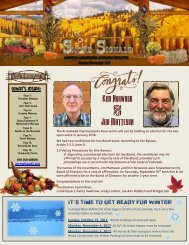AIA Smoke Signals-April/May 2018
You also want an ePaper? Increase the reach of your titles
YUMPU automatically turns print PDFs into web optimized ePapers that Google loves.
Feeding Wildlife Puts Everyone at Risk!<br />
Colorado is blessed with a diversity of wildlife. Our elk population is larger than that of any other state or Canadian<br />
province. In addition, our state is home to an abundant, thriving deer population.<br />
The Colorado Parks and Wildlife—whose mission is to protect and enhance the state’s wild creatures—knows how much<br />
people love Colorado wildlife. They love to watch the animals, learn about them, photograph them, hunt them and, on<br />
occasion, even feed them.<br />
We know people mean well when they give tidbits to wildlife. What many don’t realize is that feeding big game is bad for<br />
the animals and dangerous for people. It’s also against the law. There are lots of good reasons why.<br />
While putting out food for animals like foxes and deer seems harmless, repercussions can be disastrous. Please don't feed<br />
the wildlife!<br />
Feeding Wildlife: More Harm Than Good<br />
It is illegal in Colorado to intentionally place or distribute feed, salt blocks or other<br />
attractants for big-game animals. This problem is mainly associated with deer.<br />
In the winter, deer herds tend to move to lower elevations closer to homes and<br />
businesses. Some people may feel the deer do not have adequate food sources in the<br />
wintertime and believe that supplementing their diets with grain, corn or hay is<br />
helpful. In fact, the contrary is true.<br />
“People who feed deer do more harm than good,” says Trina Lynch, a district wildlife<br />
manager with the Colorado Parks and Wildlife.<br />
The Colorado Parks and Wildlife launches controlled, emergency feeding of big-game animals only during extremely harsh<br />
winters when substantial numbers of animals are threatened. In all other cases, big-game animals are better off left to<br />
obtain their food naturally.<br />
Unwanted and Dangerous Guests<br />
According to Lynch, there are several reasons why a Colorado law passed in 1992 makes it<br />
illegal to feed big game animals. One important reason is that deer are the primary prey of<br />
mountain lions. “Concentrating deer by feeding can attract mountain lions well within the<br />
city limits. It may become necessary to kill these lions for public safety,” she says.<br />
What’s dinner for the neighborhood fox family is also a meal for other wild animals living<br />
near your home. Normally reclusive and wary, black bears will leave the woods and<br />
become accustomed to finding a meal in your backyard if you leave them something to eat.<br />
Over time, predators such as bears and mountain lions become less wary and more<br />
emboldened. They’re more likely to attack pets and people, and when that happens, it can<br />
spell death for bears and lions, which often must be destroyed to ensure public safety.<br />
From the Colorado Parks & Wildlife<br />
Photo by Richard Girvan 2017<br />
Disrupted Behavior<br />
The normal feeding behavior of big game animals allows them to spread out as they graze<br />
or browse. Artificial feeding disrupts that behavior and prompts deer to crowd together in<br />
small areas where they are more likely to be chased by dogs and hit by cars.<br />
You may delight in seeing a deer grazing in your yard. Your neighbor, however, may<br />
become irate seeing his rose bushes chomped to a stub. For farmers and ranchers, the<br />
losses can be costly from big game munching on crops or hay. Additionally, luring wildlife<br />
to your yard by putting out food could set the wild animals up for death if they have to<br />
cross highways to get to feeders or if they encounter harassment from domestic pets.<br />
What’s worse, once wildlife stop using their historic ranges, that land could end up being<br />
developed, which means the animals lose valuable habitat forever. To read more about<br />
feeding wildlife and living with wildlife in Colorado, visit Colorado Parks & Wildlife website.<br />
www.arrowhead1.org 17





